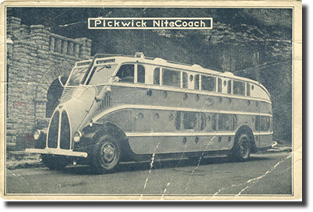
By MICHAEL BUSHNELL
Northeast News
January 29, 2014
Pickwick Lines Nite Coach service made its debut at the Pacific Southwest Exposition in Long Beach, Calif., during the summer of 1928. Movie legend Clara Bow was pictured with one of the glistening new coast-to-coast coaches and that picture ran in newspapers nationwide, all heralding the arrival of luxury coast-to-coast bus service.
An excerpt from the Aug. 14, 1928, Madison Wisconsin Capital Times reads: “Newest Motor Coach Is Veritable Hotel on Wheels Has Dining Rooms, Berths and Balcony. $30,000 Vehicle Will Be Used On San Diego, ‘Frisco Trip.”
Blueprints of the monstrous bus show a central walkway down the middle of the bus, halfway between the upper and lower levels. This made it easier to slip down into or step up into the sleeping berths. The driver was situated above the motor, almost eight feet above the roadway. The steward had a small kitchen prep area at the front of the bus that served meals to the 28 guests upon request. Each delivered to your stateroom which incidentally featured running water and electric lighting. Each coach was equipped with two lavatories, too.
This black and white photo postcard was taken on Kersey Coates Drive here in Kansas City. The drive is now part of the western part of the downtown loop. The description of the card reads: “First Motor Bus Compartment Sleeper, The Pickwick Nite Coach is a beautiful streamlined vehicle with 28 air cushioned chairs by day and 28 comfortable berths by night. Hot meals prepared and served on board. Two lavatories, Crew of 3, pilot, steward and porter. In successful use over Pickwick-Greyhound and affiliated lines. Pickwick-Greyhound Lines, General Offices, Railway Exchange Building, Kansas City, Missouri.”
Pickwick Lines operated out of the Pickwick Hotel downtown that doubled as the Santa Fe Trailways Stage Lines Depot. References and information for this column were researched on Coachbilt.com, a comprehensive website archiving buses and motor coaches back to their introduction in the late 1800s.



















